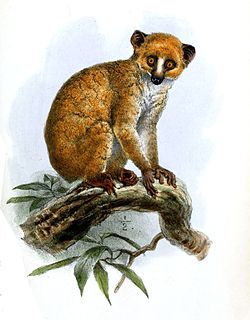| Perodicticinae | |
|---|---|
 | |
| Calabar angwantibo, Arctocebus calabarensis | |
| Scientific classification | |
| Kingdom: | Animalia |
| Phylum: | Chordata |
| Class: | Mammalia |
| Order: | Primates |
| Suborder: | Strepsirrhini |
| Family: | Lorisidae |
| Subfamily: | Perodicticinae Gray, 1870 |
| Type genus | |
| Perodicticus Bennet, 1831 | |
| Genera | |
Perodicticinae is a subfamily of the family Lorisidae. It includes five species of African primates as shown under taxonomy below.
Contents
They have a vestigial tail and index finger. The snout is pointed and the ears and eyes are large. The coat is dense, brown and woolly.